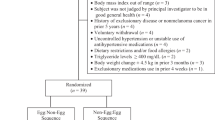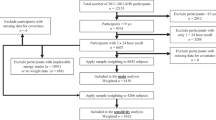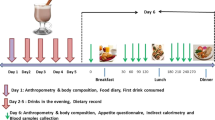Abstract
Background: There is a need for objective and universally applicable biomarkers for the intake of foods believed to affect human health.
Objective: The purpose of this feeding study was to test whether plasma concentrations of carotenoids could be used to distinguish recommended consumption of mixed fruits and vegetables (five a day) from the current national intake of fruits and vegetables (two a day).
Design: A strict crossover design was chosen to correct for observed interindividual variations in carotenoid response. A total of 40 healthy subjects were included in the study. After 1 week run-in period with no fruits and vegetables in the diet, one group was given two portions (300 g) of fruits and vegetables daily, while another group was given five portions (750 g) for 14 days. Following a 2 week wash-out period and 1 week run-in, the regimens were switched between the groups. Fruits and vegetables were combined to match a typical Norwegian diet.
Results: Enhanced intake from two to five portions of mixed fruits and vegetables increased plasma concentrations of α-carotene (P=0.033) and lutein (P=0.051) in a crossover analysis. Analysis of data in the parallel part of the study revealed differences between the high and low intake for plasma concentrations of α-carotene (P=0.013) and β-carotene (P=0.016). A trend was also evident for plasma concentrations of lycopene (P=0.057) and lutein (P=0.076) in the parallel analysis. No effect of high vs low intake of fruits and vegetables was observed for plasma concentrations of β-cryptoxanthin, zeaxanthin, cholesterol and triacylglycerols.
Conclusion: The study indicates that plasma concentration of α-carotene, β-carotene and lutein may be used to assess changes of fruit and vegetable intake corresponding to an increase from the present national intake in Norway to the recommended amount of five portions of fruits and vegetables daily.
Sponsorship: Norwegian Research Council, National Nutrition Council, Throne Holst Foundation for Nutrition Research and Freia Chokoladefabriks Medisinske Fond.
This is a preview of subscription content, access via your institution
Access options
Subscribe to this journal
Receive 12 print issues and online access
$259.00 per year
only $21.58 per issue
Buy this article
- Purchase on Springer Link
- Instant access to full article PDF
Prices may be subject to local taxes which are calculated during checkout
Similar content being viewed by others
References
Agudo A, Slimani N, Ocke MC & Naska A (2002): Vegetable and fruit consumption in the EPIC cohorts from 10 European countries. IARC Sci. Publ. 156, 99–103.
Alberg A (2002): The influence of cigarette smoking on circulating concentrations of antioxidant micronutrients. Toxicology 180, 121–137.
Almendingen K, Trygg K & Pedersen JI (1998): An assessment of the use of simple methods to predict individual energy intakes for intervention studies. Eur. J. Clin. Nutr. 52, 54–59.
Altman DG (1991): Practical Statistics for Medical Research. London: Chapman & Hall/CRC.
Arab L & Steck S (2000): Lycopene and cardiovascular disease. Am. J. Clin. Nutr. 71, 1691S–1695S.
Block G, Norkus E, Hudes M, Mandel S & Helzlsouer K (2001): Which plasma antioxidants are most related to fruit and vegetable consumption? Am. J. Epidemiol. 154, 1113–1118.
Block G, Patterson B & Subar A (1992): Fruit, vegetables, and cancer prevention: a review of the epidemiological evidence. Nutr. Cancer 18, 1–29.
Broekmans WM, Klopping-Ketelaars IA, Schuurman CR, Verhagen H, van den Berg H, Kok FJ & van Poppel G (2000): Fruits and vegetables increase plasma carotenoids and vitamins and decrease homocysteine in humans. J. Nutr. 130, 1578–1583.
Brown ED, Micozzi MS, Craft NE, Bieri JG, Beecher G, Edwards BK, Rose A, Taylor PR & Smith Jr JC (1989): Plasma carotenoids in normal men after a single ingestion of vegetables or purified beta-carotene. Am. J. Clin. Nutr. 49, 1258–1265.
Burri BJ, Neidlinger TR & Clifford AJ (2001): Serum carotenoid depletion follows first-order kinetics in healthy adult women fed naturally low carotenoid diets. J. Nutr. 131, 2096–2100.
Campbell DR, Gross MD, Martini MC, Grandits GA, Slavin JL & Potter JD (1994): Plasma carotenoids as biomarkers of vegetable and fruit intake. Cancer Epidemiol. Biomarkers Prev. 3, 493–500.
Drewnowski A, Rock CL, Henderson SA, Shore AB, Fischler C, Galan P, Preziosi P & Hercberg S (1997a): Serum beta-carotene and vitamin C as biomarkers of vegetable and fruit intakes in a community-based sample of French adults. Am. J. Clin. Nutr. 65, 1796–1802.
Drewnowski A, Rock CL, Henderson SA, Shore AB, Fischler C, Galan P, Preziosi P & Hercberg S (1997b): Serum beta-carotene and vitamin C as biomarkers of vegetable and fruit intakes in a community-based sample of French adults. Am. J. Clin. Nutr. 65, 1796–1802.
El Sohemy A, Baylin A, Kabagambe E, Ascherio A, Spiegelman D & Campos H (2002): Individual carotenoid concentrations in adipose tissue and plasma as biomarkers of dietary intake. Am. J. Clin. Nutr. 76, 172–179.
FAO/WHO/UNU Expert Consulation (1985): Energy and Protein Requirements. Geneva: World Health Organisation.
Goodwin TW (1986): Metabolism, nutrition, and function of carotenoids. Annu. Rev. Nutr. 6, 273–297.
het Hof KH, Brouwer IA, West CE, Haddeman E, Steegers-Theunissen RP, van Dusseldorp M, Weststrate JA, Eskes TK & Hautvast JG (1999): Bioavailability of lutein from vegetables is 5 times higher than that of beta-carotene. Am. J. Clin. Nutr. 70, 261–268.
Holden JM, Eldridge AL, Beecher GR, Buzzard IM, Bhagwat S, Davis CS, Douglass LW, Gebhardt S, Haytowitz D & Schoenberg JB (1999): Carotenoid content of U.S. foods: an update of the database. J. Food Compos. Anal. 12, 169–196.
Horner NK, Patterson RE, Neuhouser ML, Lampe JW, Beresford SA & Prentice RL (2002): Participant characteristics associated with errors in self-reported energy intake from the Women's Health Initiative food-frequency questionnaire. Am. J. Clin. Nutr. 76, 766–773.
Johansson L & Andersen LF (1998): Who eats 5 a day?: intake of fruits and vegetables among Norwegians in relation to gender and lifestyle. J. Am. Diet. Assoc. 98, 689–691.
Leth T, Jakobsen J & Andersen NL (2000): The intake of carotenoids in Denmark. Eur. J. Lipid Sci. Technol. 128–132.
Martini MC, Campbell DR, Gross MD, Grandits GA, Potter JD & Slavin JL (1995): Plasma carotenoids as biomarkers of vegetable intake: the University of Minnesota Cancer Prevention Research Unit Feeding Studies. Cancer Epidemiol. Biomarkers Prev. 4, 491–496.
Naska A, Vasdekis VG, Trichopoulou A, Friel S, Leonhauser IU, Moreiras O, Nelson M, Remaut AM, Schmitt A, Sekula W, Trygg KU & Zajkas G (2000): Fruit and vegetable availability among ten European countries: how does it compare with the ‘five-a-day’ recommendation? DAFNE I and II projects of the European Commission. Br. J. Nutr. 84, 549–556.
Olson JA (1989): Biological actions of carotenoids. J. Nutr. 119, 94–95.
Pocock SJ (1983): Clinical Trials; A Practical Approach. London: John Wiley and Sons.
Polsinelli ML, Rock CL, Henderson SA & Drewnowski A (1998): Plasma carotenoids as biomarkers of fruit and vegetable servings in women. J. Am. Diet. Assoc. 98, 194–196.
Record IR, Dreosti IE & McInerney JK (2001): Changes in plasma antioxidant status following consumption of diets high or low in fruit and vegetables or following dietary supplementation with an antioxidant mixture. Br. J. Nutr. 85, 459–464.
Rock CL (1997): Carotenoids: biology and treatment. Pharmacol. Ther. 75, 185–197.
Rock CL, Flatt SW, Wright FA, Faerber S, Newman V, Kealey S & Pierce JP (1997): Responsiveness of carotenoids to a high vegetable diet intervention designed to prevent breast cancer recurrence. Cancer Epidemiol. Biomarkers Prev. 6, 617–623.
Roodenburg AJ, Leenen R, het Hof KH, Weststrate JA & Tijburg LB (2000): Amount of fat in the diet affects bioavailability of lutein esters but not of alpha-carotene, beta-carotene, and vitamin E in humans. Am. J. Clin. Nutr. 71, 1187–1193.
Steinmetz KA & Potter JD (1991): Vegetables, fruit, and cancer. I. Epidemiology. Cancer Causes Control 2, 325–357.
van het Hof KH, Brouwer IA, West CE, Haddeman E, Steegers-Theunissen RP, van Dusseldorp M, Weststrate JA, Eskes TK & Hautvast JG (1999): Bioavailability of lutein from vegetables is 5 times higher than that of beta-carotene. Am. J. Clin. Nutr. 70, 261–268.
van Poppel G (1993): Carotenoids and cancer: an update with emphasis on human intervention studies. Eur. J Cancer 29A, 1335–1344.
van Poppel G & Goldbohm RA (1995): Epidemiologic evidence for beta-carotene and cancer prevention. Am. J. Clin. Nutr. 62, 1393S–1402S.
Yeum KJ, Booth SL, Sadowski JA, Liu C, Tang G, Krinsky NI & Russell RM (1996): Human plasma carotenoid response to the ingestion of controlled diets high in fruits and vegetables. Am. J. Clin. Nutr. 64, 594–602.
Ziegler RG, Colavito EA, Hartge P, McAdams MJ, Schoenberg JB, Mason TJ & Fraumeni Jr JF (1996a): Importance of alpha-carotene, beta-carotene, and other phytochemicals in the etiology of lung cancer. J. Natl. Cancer Inst. 88, 612–615.
Ziegler RG, Mayne ST & Swanson CA (1996b): Nutrition and lung cancer. Cancer Causes Control 7, 157–177.
Acknowledgements
We thank bioengineers Borghild Arntsen, Anne Randi Alvestad and Hanne Schulz for collection of blood samples. Finally, we thank Jette Jackobsen at the Danish Food and Veterinary Administration for determining the carotenoid content of the experimental diet. We acknowledge the financial support from Norwegian Research Council, National Nutrition Council, Throne Holst Foundation for Nutrition Research and Freia Chokoladefabriks Medisinske Fond.
Author information
Authors and Affiliations
Contributions
Guarantor: CA Drevon.
Corresponding author
Rights and permissions
About this article
Cite this article
Brevik, A., Andersen, L., Karlsen, A. et al. Six carotenoids in plasma used to assess recommended intake of fruits and vegetables in a controlled feeding study. Eur J Clin Nutr 58, 1166–1173 (2004). https://doi.org/10.1038/sj.ejcn.1601945
Received:
Revised:
Accepted:
Published:
Issue Date:
DOI: https://doi.org/10.1038/sj.ejcn.1601945
Keywords
This article is cited by
-
Development of a short food frequency questionnaire to assess diet quality in UK adolescents using the National Diet and Nutrition Survey
Nutrition Journal (2021)
-
Antioxidant vitamins and mineral supplementation, life span expansion and cancer incidence: a critical commentary
European Journal of Nutrition (2012)
-
Can we use biomarkers in combination with self-reports to strengthen the analysis of nutritional epidemiologic studies?
Epidemiologic Perspectives & Innovations (2010)
-
Effect of Spinacia oleraceae L. and Perilla frutescens L. on Antioxidants and Lipid Peroxidation in an Intervention Study in Healthy Individuals
Plant Foods for Human Nutrition (2010)
-
Validation of Overweight Children's Fruit and Vegetable Intake Using Plasma Carotenoids
Obesity (2009)



